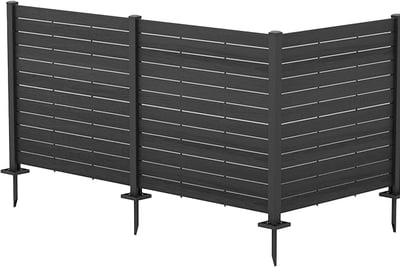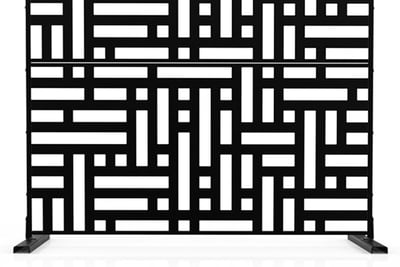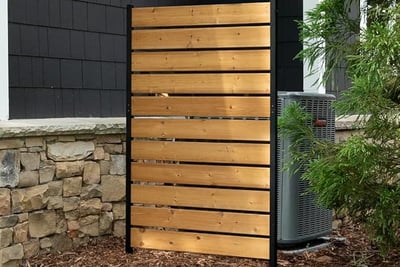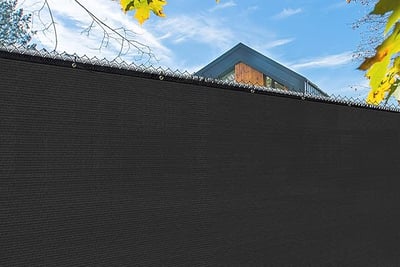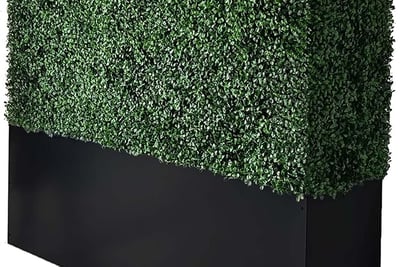How to Build a DIY Privacy Fence for Your Backyard
8 min read


Introduction to DIY Privacy Fences
As homeowners seek ways to enhance their outdoor living experience, the concept of a DIY privacy fence has gained significant popularity. A privacy fence serves multiple purposes, primarily focused on providing seclusion from the outside world, thereby enhancing personal privacy. Homeowners may feel the need for a privacy fence due to various reasons such as obscuring views from neighbors, blocking noise from nearby streets, or creating a personal sanctuary in their backyard.
In addition to privacy, these fences play a crucial role in defining property boundaries. This can be especially important in urban settings where properties are closely situated. By clearly marking the limits of one’s property, a privacy fence can help prevent disputes with neighbors, ensuring that everyone understands respective property lines. Furthermore, privacy fences can add significant aesthetic appeal to a yard, contributing to the overall landscape design.
Opting for a DIY approach to building a privacy fence offers numerous benefits for those willing to invest time and effort into the project. One of the most appealing aspects is cost savings. Hiring professionals for installation often comes with a hefty price tag; however, by taking on the project themselves, homeowners can significantly reduce expenses related to labor. This not only makes the task more economically feasible but also allows homeowners to choose their materials and designs, tailoring the fence to their personal style.
Moreover, there is a unique sense of satisfaction that accompanies completing a DIY project. Successfully building a privacy fence not only enhances the backyard but also instills a pride in homeownership. Thus, a DIY privacy fence is a rewarding venture that combines functionality, aesthetics, and personal fulfillment.
Choosing the Right Materials for Your Fence
When considering the construction of a DIY privacy fence, it is essential to select materials that align with both your functional needs and aesthetic preferences. Each material option has its unique attributes that cater to different climates, budgets, and maintenance capacities. Three popular choices for privacy fencing are wood, vinyl, and metal, each bringing distinct advantages and disadvantages.
Wood is often favored for its natural beauty and versatility. It can be easily customized, painted, or stained to match various landscapes. Common types of wood used in fencing include cedar, redwood, and pressure-treated pine. However, wood requires regular maintenance to prevent decay, splintering, and insect damage. Additionally, costs can vary significantly based on the type of wood selected, making it critical to weigh both the initial and long-term expenses.
Vinyl fencing has gained popularity for its low-maintenance characteristics and durability. Available in multiple styles and colors, it does not require painting or staining, and it generally withstands harsh weather conditions without warping or fading. Although the upfront cost of vinyl fencing can be significantly higher than wood, its longevity and reduced maintenance costs tend to justify the initial investment over time.
Metal fencing, particularly aluminum and wrought iron, offers a modern alternative with remarkable strength and minimal upkeep. Metal fences provide an exceptional level of security and can be customized for both height and design. However, they may not offer complete privacy unless combined with slats or other coverage materials. While metal fencing represents a more substantial financial commitment upfront, it is known for longevity and resilience, thus offering excellent value in the long run.
Ultimately, the decision on which material to use for your privacy fence should reflect not only the functional requirements but also the design integrations into your property. Conducting comprehensive research on each material’s characteristics will aid in making an informed choice that meets your specific needs.
Design Considerations for Your Fence
When embarking on a DIY privacy fence project, the initial step involves making thoughtful design choices that align with your backyard aesthetics and functional needs. Various styles are available, each offering unique benefits and visual appeal. Solid panels are a popular choice for homeowners seeking maximum privacy, effectively blocking sightlines from neighbors and passersby. Meanwhile, lattice tops can add an element of decorative charm, allowing you to introduce climbing plants or enhance airflow while maintaining a degree of seclusion.
Another popular trend is the horizontal slat design, which lends a modern and contemporary feel to outdoor spaces. This approach can be tailored to suit both rustic and urban environments, making it a versatile option. Consider your personal style and the overall look of your home when choosing a design; your fence should complement your existing landscape while also providing the necessary privacy you desire.
Once you have settled on a design style, the next crucial step is to take accurate measurements and plan your layout effectively. Begin by establishing your property lines, as this will dictate where your fence can legally be placed. It's important to consult your local building codes and regulations, as they may impose specific requirements regarding fence height, materials, and setbacks from property boundaries.
After determining the boundaries, sketch a layout that considers factors such as gates and access points while ensuring optimal use of space. Accessibility and maintenance should also be factored into your design, allowing you easy access for cleaning and repairs. Involving a friend or a family member in the design process can provide valuable insight and ensure that your fence reflects your vision while adhering to necessary regulations. By carefully considering these aspects, you can create a beautiful and functional privacy fence that enhances your backyard experience.
Step-by-Step Guide to Building Your Fence
Building a DIY privacy fence can be a rewarding project that enhances your backyard's aesthetics while ensuring your personal space is adequately shielded from prying eyes. The process can be broken down into several key steps, ensuring a structured approach that yields effective results.
First, it's essential to prepare the site where the fence will be installed. Begin by marking the boundaries of your property and the desired location of the fence. Use stakes and string to outline the area, ensuring compliance with local zoning laws and regulations. Once you have your layout, clear the area of any debris, plants, or obstacles that may hinder construction.
The next step involves gathering the necessary tools and materials. Generally, you will need wooden or vinyl panels (or other materials based on your design choice), fence posts, concrete mix or gravel, a level, a post hole digger, a saw, and screws or nails. Depending on the fence style you choose, you may also require additional hardware for gates, hinges, or latches.
Once you have all your materials, you can begin the installation. Start by digging holes for the fence posts, ensuring they are uniformly spaced based on the dimensions of your chosen fence style. Insert the posts into the holes, ensuring they are plumb using a level, and secure them in place with concrete or gravel. Allow the posts to set according to the manufacturer's instructions.
After the posts are secured, attach the fence panels to the posts. Ensure that each panel is level and aligned with your layout. For additional stability, consider adding diagonal braces. Finally, completing the project involves finishing touches like staining or painting the fence, which not only enhances its appearance but also prolongs its lifespan. Make sure to use high-quality exterior paint or stain to protect against weather elements.
With careful planning and execution, you will successfully construct a privacy fence that provides both beauty and functionality to your backyard space.
Incorporating Plants for Enhanced Privacy
Incorporating plants into your DIY privacy fence is an effective way to enhance both visual seclusion and the overall aesthetic appeal of your backyard. Living privacy screens not only provide the necessary barrier against prying eyes but also contribute biodiversity, improve air quality, and support local ecosystems. Utilizing plants as part of your fencing solution creates a softer, more inviting atmosphere compared to traditional static barriers.
When selecting plants for your privacy fence, it is essential to consider your climate. For temperate regions, evergreens such as Arborvitae or Leyland Cypress are excellent choices due to their dense foliage and ability to retain their leaves year-round, providing consistent privacy. In warmer climates, options like Bamboo or Southern Wax Myrtle can thrive, delivering lush greenery while thriving in full sun. Conversely, if you reside in cooler areas, deciduous plants, such as Hydrangeas or Viburnums, can offer privacy during the growing season, with the added benefit of beautiful blossoms.
To effectively integrate plants with your DIY privacy fence, consider arranging taller plants at the back and shorter varieties at the front to create a layered effect that maximizes coverage. Additionally, spacing plants appropriately will ensure adequate room for growth, preventing overcrowding. Regular maintenance, including trimming, watering, and fertilization, is crucial for a healthy living screen. Once established, these plants will not only bolster your privacy but will also offer habitat for various wildlife, enriching your outdoor space.
Incorporating a combination of plants along with your fence allows for a dynamic garden environment that adjusts with the seasons while fulfilling the desired function of a privacy barrier. Utilizing nature in this way can lead to an impressive and sustainable backyard extension that nurtures both your privacy needs and aesthetic preferences.
Pros and Cons of Different Privacy Fence Methods
When considering the construction of a privacy fence, it is essential to evaluate the various methods and materials available. Each option presents distinct advantages and disadvantages that can impact factors such as installation difficulty, long-term maintenance, costs, and privacy effectiveness.
One of the most common materials used for privacy fences is wood. Wooden fences provide an attractive, natural look and can be customized easily. They effectively block lines of sight, ensuring a high level of privacy. However, they require regular maintenance, including staining or painting, to withstand weather elements and prevent rot. Additionally, the initial cost can be significant, depending on the type of wood chosen.
Vinyl fencing is another popular option that has gained traction in recent years. One of its primary advantages is its low maintenance requirement—vinyl does not need to be painted or stained, and it is resistant to warping and splintering. Moreover, vinyl fences come in various styles, providing aesthetic flexibility. However, they can be more costly to install upfront compared to wood, and their effectiveness in harsh weather conditions can vary based on the quality of the material.
Chain-link fences topped with privacy slats offer a budget-friendly solution for those seeking a combination of security and privacy. The installation is relatively straightforward, making it a preferred choice for DIY enthusiasts. However, the aesthetics may not appeal to everyone, as chain-link fences can appear utilitarian. While slats improve privacy, they may not provide as much seclusion as wooden or vinyl options.
Metal fences, such as aluminum or wrought iron, provide durability and a sense of security. These fences require minimal maintenance and can last for years without significant wear. However, their cost can be quite high, and they may not offer the same level of privacy as other methods unless combined with materials like wood or vinyl panels. Balancing these factors will enable homeowners to make an informed decision about their privacy fence needs.
Conclusion and Final Thoughts
In summary, building a DIY privacy fence for your backyard is a rewarding and practical project that enhances both your outdoor space and privacy. Throughout this guide, we have explored the various steps involved in creating a sturdy and attractive fence, highlighting the importance of careful planning, material selection, and execution. By taking the time to design your fence thoughtfully, you ensure that it serves your needs for privacy while also complementing the aesthetic of your landscape.
Additionally, creativity plays a significant role in the construction of a privacy fence. Homeowners have the opportunity to personalize their fence design, tailoring it to fit their unique style. From choosing colors and finishes to incorporating decorative elements, each decision contributes to making the fence a true reflection of your personal taste. This personal touch not only enhances the beauty of your yard but can also increase the value of your property.
Moreover, embarking on a DIY project allows you to gain a sense of accomplishment and satisfaction from having completed the work yourself. It is essential to remember the importance of safety and following best practices throughout the construction process, ensuring that your fence is built to last and withstand the elements. As you take the initiative to transform your backyard, consider the long-term benefits of having a privacy fence, including increased comfort, security, and the ability to enjoy your outdoor space without unwanted distractions.
We encourage you to embrace this project with enthusiasm, utilizing the tips outlined in this blog post to guide your efforts. With proper planning and a bit of creativity, you can create a beautiful DIY privacy fence that not only serves your practical needs but also enhances your overall enjoyment of your backyard space.
